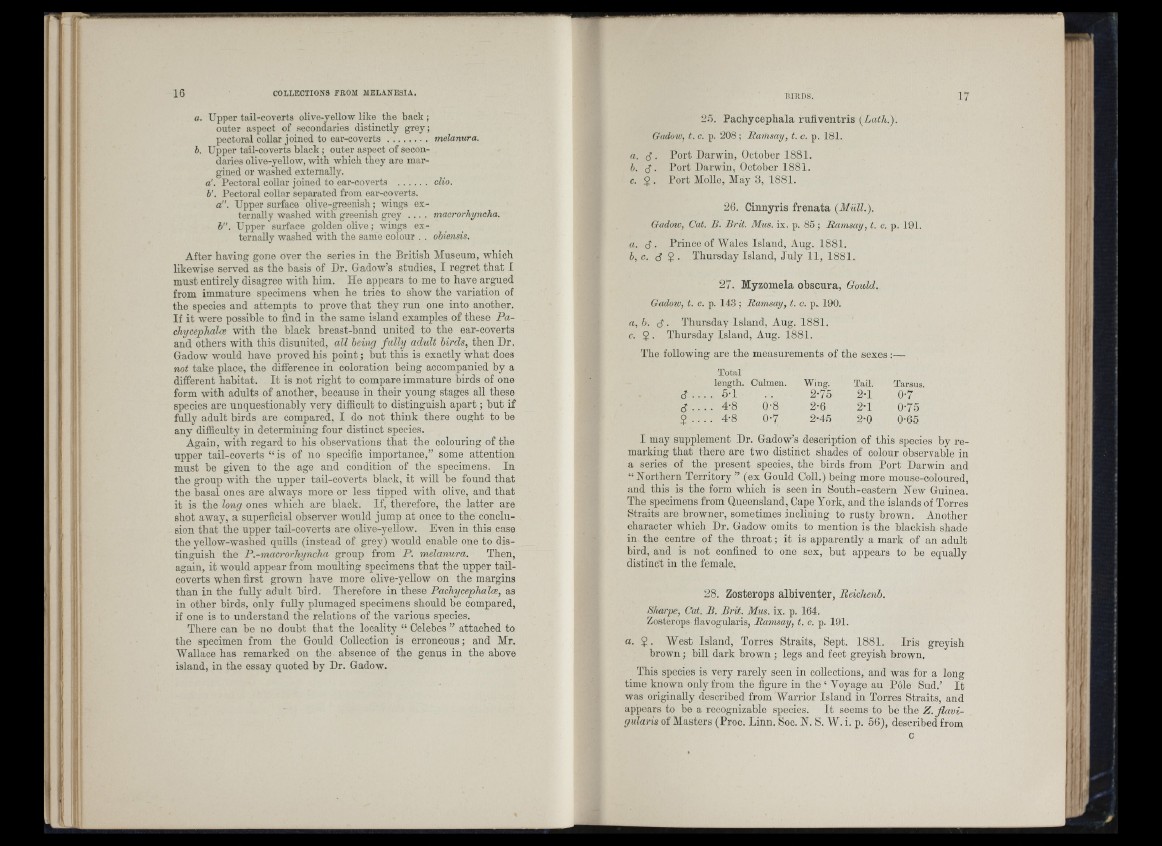
a. Upper tail-coverts olive-yellow like the back ;
outer aspect of secondaries distinctly grey;
pectoral collar joined to ear-coverts................ melanura.
h. Upper tail-coverts black ; outer aspect of secondaries
olive-yellow, with which they are margined
or washed externally.
a'. Pectoral collar joined to ear-coverts .......... clio.
b'. Pectoral collar separated from ear-coverts.
a”. Upper surface olive-greenish; wings externally
washed with greenish grey . . . . macrorhyncha.
b". Upper surface golden olive; wings externally
washed with the same colour . . obiensis.
After having gone over the series in the British Museum, which
likewise served as the basis of Dr. Gadow’s studies, I regret th at 1
must entirely disagree with him. He appears to me to have argued
from immature specimens when he tries to show the variation of
the species and attempts to prove th a t they run one into another.
I f it were possible to find in the same island examples of these Pa-
chycephalce with the black breast-band united to the ear-coverts
and others with this disunited, all being fu lly adult birds, then D r .
Gadow would have proved his p o in t; l3u t this is exactly what does
not take place, the difierence in coloration being accompanied by a
different habitat. I t is not right to compare immature birds of one
form with adults of another, because in their young stages all these
species are unquestionably very difficult to distinguish a p a r t; but if
fuUy adult birds are compared, I do not think there ought to be
any difficulty in determining four distinct species.
Again, with regard to his observations th a t the colouring of the
upper tail-coverts “ is of no specific importance,” some attention
must be given to the age and condition of the specimens. In
the group with the upper tail-coverts black, it will be found th at
the basal ones are always more or less tipped with olive, and that
it is the long ones which are black. If, therefore, the latter are
shot away, a superficial observer would jump at once to the conclusion
that the upper tail-coverts are olive-yellow. Even in this case
the yellow-washed quiUs (instead of grey) would enable one to distinguish
the P.-macrorhyncha group from P. melanura. Then,
again, it would appear from moulting specimens th at the upper tail-
coverts when first grown have more olive-yeUow on the margins
than in the fully adult bird. Therefore in these PacJiycephalce, as
in other birds, only fully plumaged specimens should be compared,
if one is to understand the relations of the various species.
There can be no doubt th at the locality “ Celebes ” attached to
the specimen from the Gould Collection is erroneous; and Mr.
Wallace has remarked on the absence of the genus in the above
island, in the essay quoted by Dr. Gadow.
2,5. Pachycephala rufiventris [^Lath.).
Gadow, t. c. p. 208; Painsay, t. c. p. 181.
a. d . Port Darwin, October 1881.
b. <S . Port Darwin, October 1881.
c. 2 . Port Molle, May 3, 1881.
26. Cinnyris frenata {Müll.).
Gadow, Cat. B. Brit. Mus. ix. p. 85 ; Ramsay, t. c. p. 191.
a. d . Prince of AVales Island, Aug. 1881.
h, c. (5 2 - Thursday Island, July 11, 1881.
27. Myzomela ohscura, Gould.
Gadoiu, t. c. p. 143 ; Ramsay, t. c. p. 190.
a, b. (S ■ Thursday Island, Aug. 1881.
e. 2 - Thursday Island, Aug. 1881.
The following are the measurements of the sexes :—
Total
length.
5-1
Culmen. Wing. Tail. Tarsus.
. . 2-75 2-1 0-7
4-8 0-8 2-6 2-1 0-75
4-8 0-7 2-45 2-0 0-65
I may supplement Dr. Gadow’s desorijfiion of this species by remarking
that there are two distinct shades of colour observable in
a series of the present species, the birds from Port Darwin and
“ Northern Territory ” (ex Gould Coll.) being more mouse-coloured,
and this is the form which is seen in South-eastern New Guinea.
The specimens from Queensland, Cape York, and the islands of Torres
Straits are browner, sometimes inclining to rusty brown. Another
character which Dr. Gadow omits to mention is the blackish shade
in the centre of th e th ro a t; it is apparently a mark of an adult
bird, and is not confined to one sex, but appears to be equally
distinct in the female.
28. Zosterops alhiventer, Beichenh.
Sharpe, Cat. B. Brit. Mus. ix. p. 164.
Zosterops flavogularis, Bamsay, t. c. p. 191.
a. 2 . West Island, Torres Straits, Sept. 1881. Iris greyish
brown ; bill dark brown ; legs and feet greyish brown.
This species is very rarely seen in collections, and was for a long
time known only from the figure in the ‘ Voyage an Pôle Sud.’ I t
was originally described from Warrior Island in Torres Straits, and
appears to be a recognizable species. I t seems to be the Z .fiu v i-
p u k ris of Masters (Proc. Linn. Soc. N. S. VY. i. p. 56), described from
c